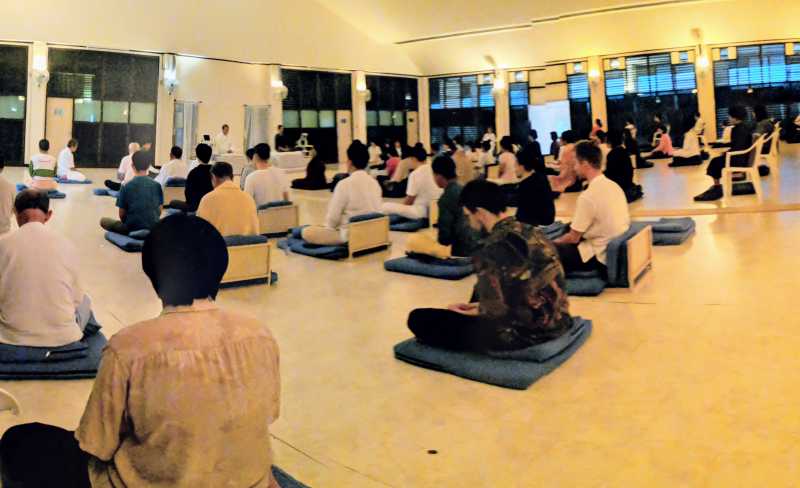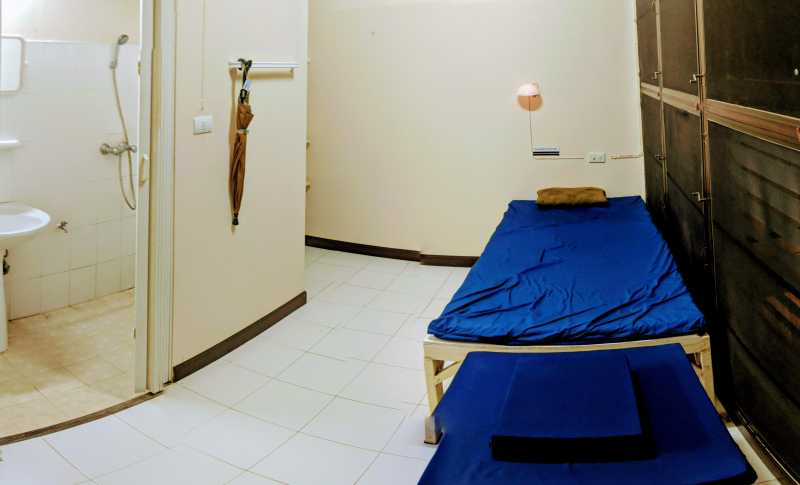Living like a Buddhist monk
10 days of silent meditation
My ass hurt, my concentration was gone and time seemed to stand still. I squinted open my eyes just enough to see motionless silhouettes sitting like statues of Buddha in a dim-lit room. Finally, low, soothing Hindi chants, reminding me of Muslim prayers howled from minarets, broke the silence to bring sweet relief: two more hours of meditation were over. And in a sleep-walking like manner, the silhouettes erected silently from their pillows and walked, head down and with short, slow steps, out of the meditation hall.

The start of this 10-day camp was as straight-forward as it was terrifying: A tuk-tuk drives me to a secluded forest area a few kilometers south of Chiang Mai. I'm greeted by a friendly Thai, verify my name in a sign-up sheet and am then given a cloth bag. I see a rusty sign behind the desk: "Please deposit all valuables, money, phone, books, laptop, watch until the course ends". So I hand over my cash, credit cards, passport, kindle, laptop. Stripped of everything that verifies my existence in this world, the man leads me to my bedroom and just like that 10 silent days of information detox began.
Daily structure
Each day has the same, rigorous structure: wake up bell at 4am, meditate, breakfast, meditate, lunch, rest, meditate, afternoon tea, meditate, video lesson and lights out at 9:30pm. There is no watch required or a schedule to occupy the mind, as a bell rings for every event. There was something liberating about leaving the room with only flip-flops, loose pants, and a T-shirt. Nothing to forget, nothing to add - nothing to think about. It was surprisingly easy to get up at 4am. Six and half hours of sleep proved sufficient to sustain this low physical exertion lifestyle. It was still dark, crickets were not even chirping yet, the air was pleasantly cool, and mind and body were calm. After morning meditation it was peaceful watching the sun rise behind the hills under the soothing Hindi chants coming from a crackling old megaphone loudspeaker.


Food was served in a large hall, seats assigned by room number facing the window. We received one plate, spoon, fork, a cup, a soup bowl, and a cloth napkin to be used for the entire duration of the camp. After dinner, everyone washed their own dishes in the sink, each equipped with exactly one sponge and one soap. Nothing extra laying around, nothing to be confused about, minimal but sufficient. I liked that. The food was fresh, vegetarian and with lots of local fruits. Nothing fancy, but tasty. And for the days the food wasn't quite my flavor, I just convinced myself that now it must be especially healthy - the typical parent-spinach-trick.

Every evening we watched videos of a Burmese meditation teacher explain the meditation technique and how it connects to Buddhism. These talks also addressed fundamental questions like how to live life in a surprisingly philosophically sound manner and I found them very interesting (possibly also because they were the only source of new information each day).
Every time the bell for meditation rang everyone gathered in a large hall, lights dimmed, fans soothingly hissing. A gray carpet divided the meditation hall into male and female, with entrances on opposite sides. Since this is the only time that both genders are together, I was naturally curious about the women participating in this course and examined the other side of the carpet before starting to meditate. A rookie mistake, as I realized after the first day. The entire setting of the camp, the structured day, the absolute silence towards other meditators, the absence of one's phone and books existed to avoid feeding the mind with additional input; to starve the mind from new information, so that it can focus, without distraction, towards the exercises of meditation. And when your mind already has so little to work with, feeding the male mind with images of the opposite sex is like drinking a red bull before going to sleep. So starting the next day, I walked in head down, sat in my spot and cautiously closed my eyes for meditation immediately.
Vipassana meditation
The main objective in Vipassana meditation is to become a better person for yourself and subsequently for the benefits of others by being more aware of your thoughts. In general, I was pleased that there were very little supernatural or esoteric aspects. Vipassana prides itself with being "scientific" and pragmatic and, from my brief experience, mostly remains true to this claim.
Have you ever had this sudden itch somewhere although nothing was there? We usually just scratch it without thinking about it. Just like this itch, many more sensations are happening throughout the body that don't even make it to the conscious part of our mind. By pausing our stream of thoughts and attentively focusing on different parts of the body, we are able to detect more subtle sensations that otherwise go unnoticed. So for the first days, the task was to detect any type of sensations, itching, tingling, coolness, warmness, on the rectangular mustache area above the upper lip and below the nostrils. This is a lot easier said than done. I focus on that area, trying to feel the air-flow of breath on my upper lip: in... out... in... – blackout! Ten minutes later I catch my thoughts again, I realize I just planned my entire trip from Thailand to Cambodia... I wonder what locals eat in Cambodia...actually, what's for lunch today, I'm starving... I hope it's strawberries, could really go for some of those... I remember that time I had strawberries with my ex, wonder what she's up to now... I think she lives in Munich, that's such a nice city, they surf in the river, how cool is that... I should definitely go surfing in Bali. Shit! Come on Alex, this cannot be that difficult! And I start again, breathe in... out... in.... out – gone again.
After some training, I was able to focus for about a minute before the mind ran off. Then, all of a sudden an itch popped up a few millimeters below my right nostril. Hurraaaay, I'm meditating! But wait, what if this was just a peculiar coincidence? However, as my mind became calmer and this area was able to receive my undivided attention for multiple minutes, more and more sensations started revealing themselves. The sporadic itch became a regular visitor, sometimes subtle, other times so strong that resisting to scratch it was nearly impossible. But there were also other types of sensations appearing. I felt the breath cooling the inside of my nose, I felt slightly warmer air exhaled and mostly through my right nostril, sometimes I felt a subtle twitching of my upper lip, I started feeling a pleasant tingling sensation, like low-intensity goose-bumps, first localized, but eventually covering the entire mustache area.
It was fascinating that solely by mental focus I could generate these sensations at different patches of skin throughout the body. I found it a bit like learning how to wink: at first, your entire face moves, creating grotesque images no one deserves to see. Then, maybe by sheer luck, you relaxed parts of your face while activating the precise muscles responsible for closing the right eye. And with practice you are able to reproduce this concise activation more and more reliably. In meditation, you are activating nerves instead of muscles. With practice, I was able to give high priority to the nerves connecting to the upper lip. The input from these nerves is propagated into consciousness, while other nerves are ignored. I felt an abundance of sensations, which were always there, but now received the mind's conscious attention.
The actual goal, after having sharpened the mind to detect sensations at different patches of skin, is to _not react_ to them. You should neither crave more of the pleasant tingling nor generate a feeling of aversion towards negative sensations, like pain in the lower back. The mind should stay absolutely balanced equanimous, making no distinction between pleasant and unpleasant sensations. This aligns with Buddhist theory that all misery comes from the mind generating craving or aversion. Meditation can be seen as first level training: no visual input, no sound, just sitting in a silent room. After mastering awareness and not reacting to bodily sensation in this easy-peasy setting, the next step is to not react to stimuli of the outside world -- like the dick in a Mustang cutting you off in traffic, but also the sincere compliment from your boss.
Noble silence
One of the hardest parts for me during these 10 days was the Noble silence. This didn't just prohibit one from speaking with other meditators, but also forbid eye contact or other nonverbal communication, like a smile. Everyone was constantly looking at their feet when walking. The course encouraged one to "cultivate the feeling as if one were alone". And even though we were physically so close (we were eating almost shoulder to shoulder) the lack of communication created total isolation. I'm far from an extrovert, but still, I missed seeing smiles, or hearing laughter. I wasn't sad, but also not happy. I guess that's the mental state they tried to cultivate.
I remember the evening of the 6th day, it was already dark and everyone was strolling slowly, head down, on the walking path. Suddenly, on the far side of the path, one could faintly hear cheerful country music playing. No one has heard music for days, and for a few minutes many gathered on this far side of the path and just stood still, looking out into the black night. The cheerful music proved that the outside world was still there. I really enjoyed this moment, as it gave me a glimpse into the mind of others. People standing still broke the rule of non-verbal communication. It revealed that many were struggling with the isolation from each other and the outside world. And understanding that we were all sharing these struggles created an encouraging feeling of connection.

Apart from the ants crawling in a surprisingly organized fashion over the cracks in the walking path, the other humans were the only interesting source of external information. I've lived so close to these people but knew nothing about them. So naturally, I made up elaborate stories about the language they might speak, if they have this high pitch voice or low bass, whether they are a yoga instructor or an investment banker. Midway through day 10, the Noble silence restriction was lifted. The idea was to gradually transition back into the outside world, to not get slapped in the face with sudden information overload after 10 days of seclusion. This is when I learned I spent the last 216 hours with a Karate teacher from Germany, an Uber Manager from the US, a raw vegan cook from Romania, a Pizza-delivery guy from Thailand, and many more people from all over the world. It was surprising to hear that behind the emotionless faces, almost everyone was internally struggling at one time or another. I also realized I wasn't the only one who found it fascinating to watch the red ants carry massive leaves. Everyone saw the dead scorpion on day 3 on the side of the walkway! And many were grossed out by the snot snorting of the Burmese meditation teacher in the videos.
Lessons learned
So what did I learn? Did these 10 days of seclusion and deep introspection fundamentally change my perspective on life? A bit, but it wasn't the actual Vipassana meditation, but more the absence of distraction, the information-detox, that revealed new insights. As humans, we are constantly thinking of something, usually steered by the information on our screen or the conversations with other humans. Take that away, and the information starving mind is forced to use what's already inside. After a few days, I noticed how some scenarios I played in my head kept on repeating themselves. A similar train of thoughts coming up day after day hinting at what might occupy the mind on a more subconscious level. Quietly steering my life, while the conscious brain is distracted by the waterfall of new, mostly irrelevant information. I had two specific cravings around many of my thoughts kept on drifting, and I realized that I actually don't want these to influence my decisions in the strong way they probably do. So now, I am trying to catch myself when I think, say or do something that nourishes these cravings. The hope is that by stopping to nourish them, they slowly fade and stop having such a strong say in my life.
So who would I recommend this course for? This course was not a fun experience or a relaxing vacation, rather more like a boot camp that you feel satisfied after having completed. But if you're up for a challenge, want to experience the life of a monk for 10 days, open to listen to devotions on Buddhism instead of Christianity, suspecting you are distracting your mind day by day to suppress some underlying thoughts, or just want to hear some different perspectives on how to live life, then I'm sure you'll get something out of it. At the very least, I realized that 10 days without Netflix is physically possible without going into septic shock.
Links
Follow me on edium or enter your email below to get notified about new posts.